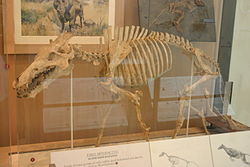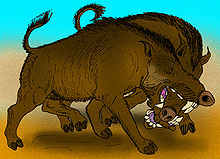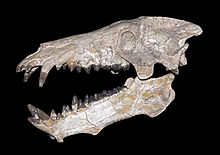- Archaeotherium
-
Archaeotherium
Temporal range: Early Oligocene
Archaeotherium mortoni skeleton Scientific classification Kingdom: Animalia Phylum: Chordata Class: Mammalia Order: Artiodactyla Family: †Entelodontidae Genus: †Archaeotherium
Leidy (1850)Archaeotherium (Greek, "Ancient Beast") is an extinct artiodactyl genus of the family Entelodontidae, endemic to North America during the Oligocene epoch (38—24.8 mya), existing for approximately 6 million years.[1] Archaeotherium was about 1.2m tall at the shoulder and around 2m long and weighing around 270kg.
It was a relative of javelinas and pigs. Evidence from the Wyoming Dinosaur Center suggests that Archaeotherium, like modern carnivores, kept caches of food when their hunting was unsuccessful. These bones were mainly those of Poebrotherium.[citation needed]
Contents
Taxonomy
Archaeotherium was named by Leidy (1850). Its type is Archaeotherium mortoni. It was synonymized subjectively with Entelodon by Joseph Leidy (1853) and synonymized subjectively with Elotherium by Leidy (1857). It was assigned to Entelodontidae by Leidy (1850), Peterson (1909), Scott (1940), Galbreath (1953), Russell (1980), Carroll (1988) and Effinger (1998).[2][3]
Morphology
In life, Archaeotherium probably resembled a large, fanged, peccary with bumps projecting from the side of its head. It had high shoulders, presumably to carry strong neck muscles to support the heavy head. The brain was tiny, but had relatively large olfactory lobes, suggesting that the animal had a keen sense of smell.[4]
The largest (and type) species, A. mortoni was an aggressive, cow-sized apex predator. Rhino jaws and other mammal bones have been found with bite marks on them that match the large canines of A. mortoni. A fossil trackway in Toadstool Park depicts the path of a Subhyracodon walking forward, stopping to see an Archaeotherium approach, then breaking into a gallop with the entelodont chasing after it.[citation needed] In leaner times, it is suggested that Archaeotherium dug for roots and tubers, as with other pig-like mammals.[4]
Body mass
A single specimen was examined by M. Mendoza, C. M. Janis, and P. Palmqvist for body mass and was estimated to have a weight of 1,091.8 kg (2,400 lb). The second was estimated to have a weight of 129.1 kg (280 lb).[5]
References
- ^ PaleoBiology Database: Archaeotherium, basic info
- ^ O. A. Peterson. 1909. Memoirs of the Carnegie Museum
- ^ W. B. Scott. 1940. The mammalian fauna of the White River Oligocene; Part 4, Artiodactyla; Part 5, Perissodactyla. Transactions of the American Philosophical Society 28(4):363
- ^ a b Palmer, D., ed (1999). The Marshall Illustrated Encyclopedia of Dinosaurs and Prehistoric Animals. London: Marshall Editions. p. 267. ISBN 1-84028-152-9.
- ^ M. Mendoza, C. M. Janis, and P. Palmqvist. 2006. Estimating the body mass of extinct ungulates: a study on the use of multiple regression. Journal of Zoology 270
- Prehistoric even-toed ungulate stubs
- Entelodonts
- Oligocene mammals
- Oligocene extinctions
- Fossil trackways
- Prehistoric mammals of North America
- White River Fauna
Wikimedia Foundation. 2010.


